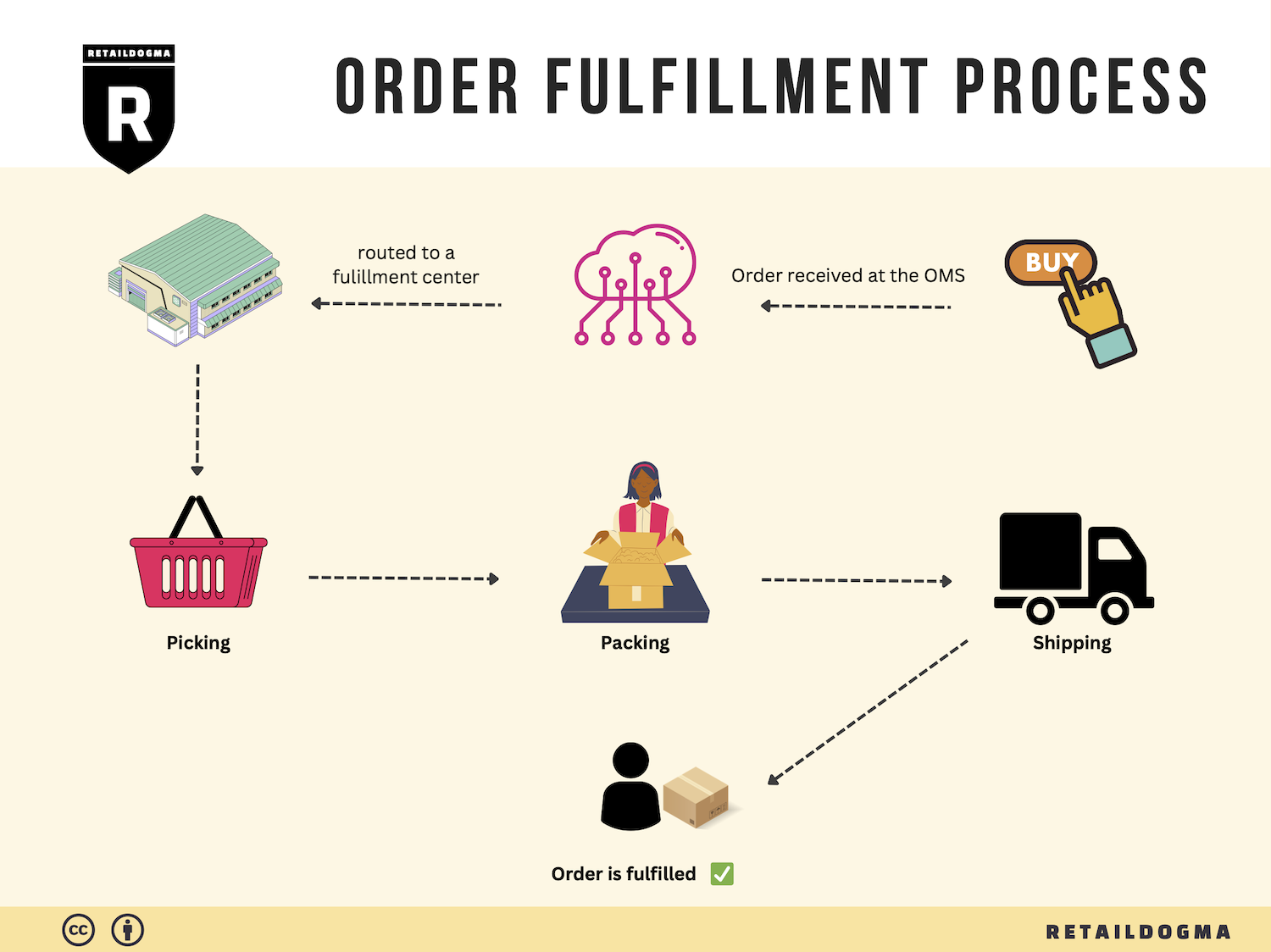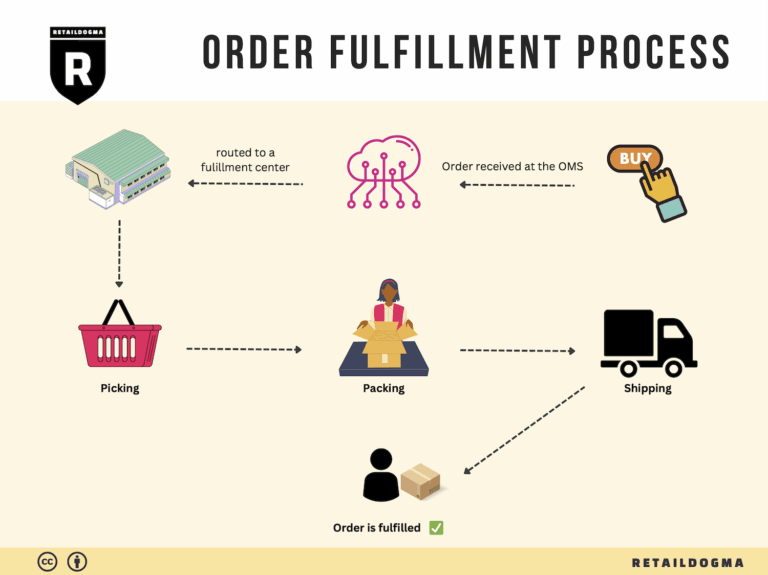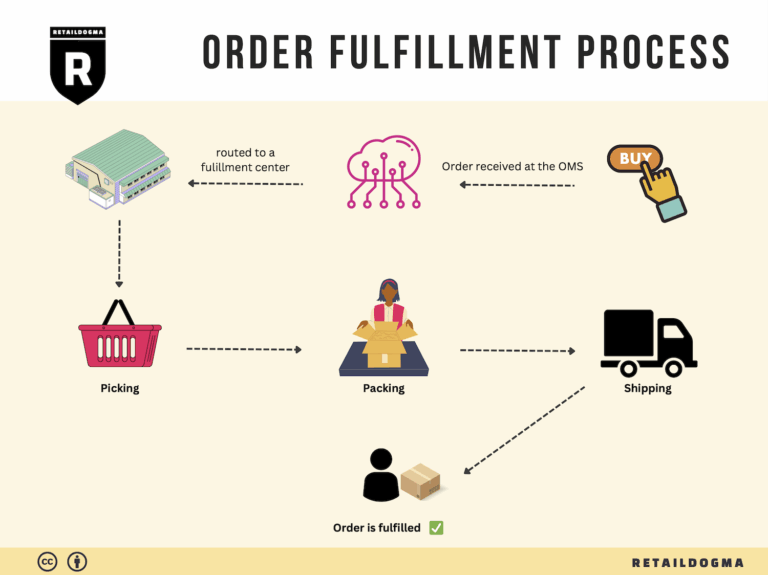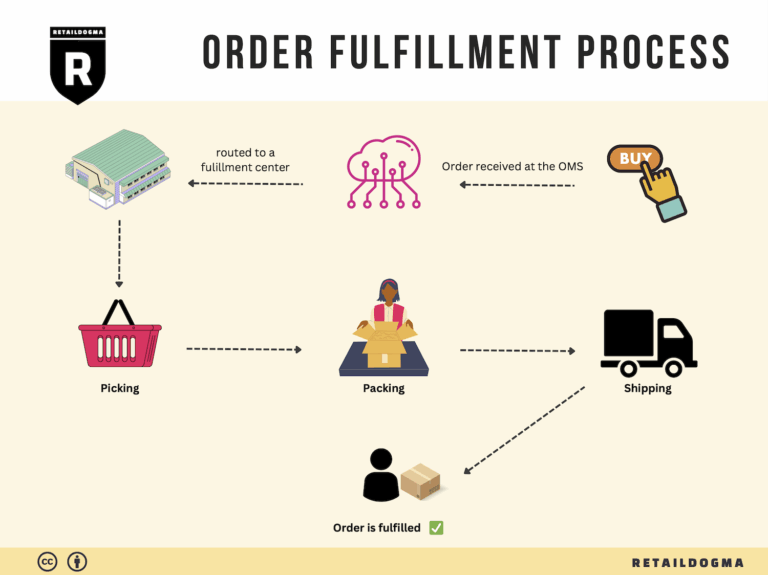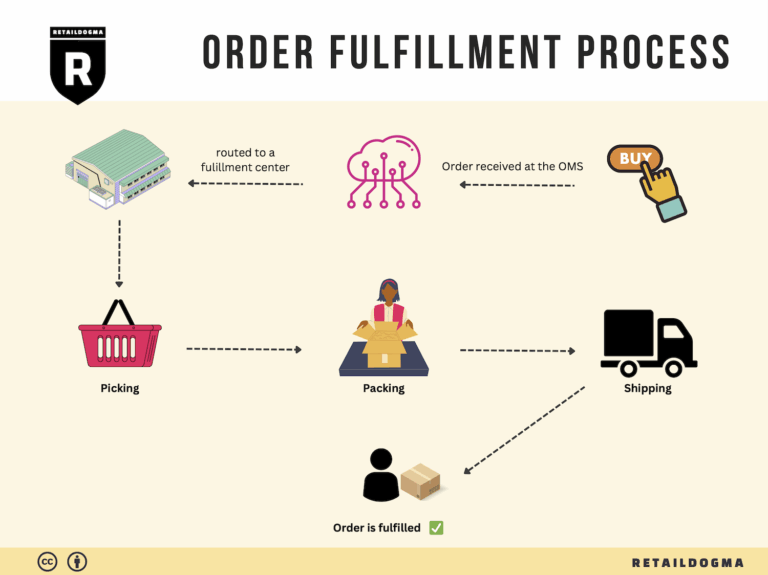What Is A Fulfillment Center? A Complete Guide (2025)
What is E-commerce Fulfillment? An Introduction for Growing Businesses
Running a growing e-commerce business often means navigating a myriad of operational challenges, and one of the most overwhelming aspects can be the packing and shipping of orders. As your sales increase, so does the complexity of fulfilling those orders—leading to potential delays, errors, and customer dissatisfaction. This is where effective e-commerce fulfillment comes into play.
Understanding E-commerce Fulfillment
At its core, e-commerce fulfillment is the process of getting a product from your inventory to your customer’s doorstep. This involves several crucial steps, including inventory management, order processing, packing, shipping, and handling returns. For many business owners, the logistics of fulfillment can quickly become a bottleneck, diverting focus from growth and customer engagement to operational headaches.
What This Guide Will Cover
This guide aims to demystify the various aspects of e-commerce fulfillment, equipping you with the knowledge to make informed decisions about your logistics strategy. We will explore different fulfillment models, including:
- Third-Party Logistics (3PL): Partnering with external companies to manage your inventory and shipping needs.
- Fulfillment by Amazon (FBA): Leveraging Amazon’s extensive logistics network to handle storage, packing, and shipping for your products.
We will outline the core services typically offered in fulfillment solutions, such as inventory storage, order processing, packing, shipping, and customer support. Understanding these services will help you identify which elements are essential for your business model.
Choosing the Right Fulfillment Partner
Finding the right fulfillment partner can significantly impact your operational efficiency and customer satisfaction. This guide will provide practical tips on evaluating potential partners, considering factors such as their technology, service offerings, geographical reach, and pricing structures.
Pricing Considerations
Cost is always a concern for growing businesses. We will break down common pricing models in fulfillment, helping you understand how to budget for these services without compromising on quality.

Empowering Your Business Decisions
The ultimate goal of this guide is to empower you to make smart, strategic decisions regarding your e-commerce fulfillment. By understanding the landscape and options available, you can choose a fulfillment strategy that not only meets your current needs but also scales with your business as it grows. With the right approach, fulfillment can become a competitive advantage rather than a cumbersome challenge.
What You’ll Learn In This Guide
- What is E-commerce Fulfillment? An Introduction for Growing Businesses
- The Order Fulfillment Process: From ‘Buy’ Button to Customer’s Door
- Comparing Fulfillment Models: In-House vs. 3PL vs. Dropshipping
- A Deep Dive into Amazon FBA: Pros, Cons, and Who It’s For
- Core Services Offered by Fulfillment Centers
- How to Choose a Fulfillment Partner: A 6-Point Checklist
- Understanding Fulfillment Pricing: A Breakdown of Common Fees
- Frequently Asked Questions (FAQs) about Fulfillment
- Conclusion: Is Outsourcing Fulfillment the Right Move for Your Business?
- Important Disclaimer
The Order Fulfillment Process: From ‘Buy’ Button to Customer’s Door
1. Receiving Inventory
The order fulfillment process begins with receiving inventory. This step involves the arrival of products from suppliers or manufacturers at the fulfillment center. When inventory is received, it is crucial to perform a quality check to ensure that the items match the purchase order in terms of quantity and condition. This is where the concept of Stock Keeping Units (SKUs) comes into play. Each product is assigned a unique SKU that allows for efficient tracking and management.
Proper inventory receiving is vital for several reasons. It prevents stock discrepancies that can lead to overselling or stockouts, both of which can damage customer trust. Additionally, accurate receiving helps maintain accurate inventory records, which is essential for future forecasting and inventory management. By utilizing technology such as barcode scanners during this phase, e-commerce businesses can streamline the process, reduce errors, and maintain a high level of operational efficiency.
2. Warehouse Storage
Once the inventory is received and verified, the next step is warehouse storage. This involves organizing the products within the fulfillment center for easy access. Efficient warehouse storage maximizes space and minimizes the time taken to retrieve items when orders are placed. A common practice in this phase is the use of a Warehouse Management System (WMS), which helps in categorizing and locating products based on their SKUs.
The importance of effective storage cannot be overstated. A well-organized warehouse allows for faster order fulfillment, which is critical in today’s fast-paced e-commerce environment. Moreover, it reduces labor costs and increases the overall efficiency of the operation. By using storage techniques such as slotting, where frequently picked items are stored closer to packing areas, businesses can significantly enhance their picking efficiency.
3. Order Picking
The third step in the fulfillment process is order picking, where items are selected from their storage locations to fulfill customer orders. This process often utilizes pick lists—documents that specify the items and quantities needed for each order. There are various picking methods, including single order picking, batch picking, and zone picking, each tailored to different operational needs.
Order picking is crucial as it directly affects the accuracy and speed of order fulfillment. Errors in this stage can lead to incorrect shipments, resulting in customer dissatisfaction and increased return rates. Implementing technology such as pick-to-light systems or voice picking can greatly improve picking accuracy and speed. The efficiency of this step also has a ripple effect on subsequent stages, highlighting the importance of optimizing the picking process.
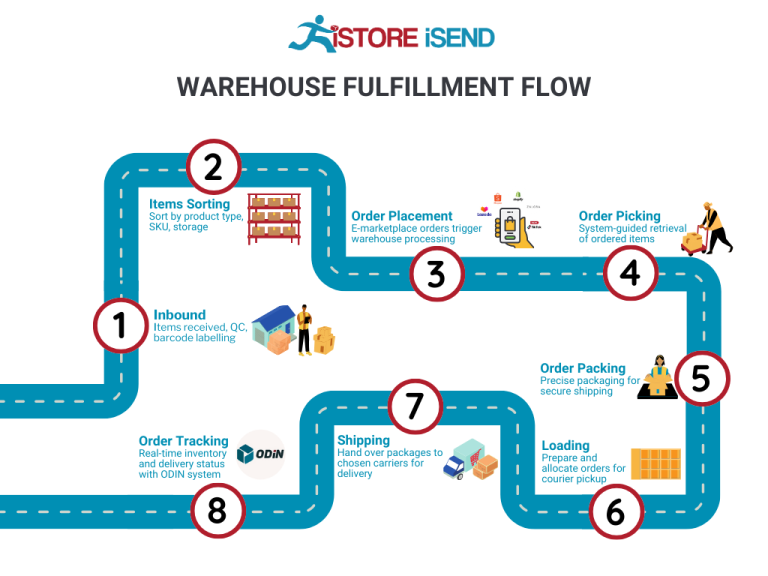
4. Order Packing
After the items are picked, they move on to the packing stage. This involves securely packing the selected products to ensure they arrive at the customer’s doorstep in perfect condition. During this phase, businesses must consider packaging materials, dimensions, and weight, which can affect shipping costs. Utilizing packing slips—documents that accompany the package and outline the contents—is also common practice.
The packing process is important for several reasons. Proper packing not only protects the products during transit but also enhances the customer experience. A well-packed order reflects professionalism and attention to detail, which can foster customer loyalty. Additionally, efficient packing practices can reduce shipping costs by optimizing package sizes, which is essential for maintaining competitive pricing in e-commerce.
5. Shipping & Delivery
The final step in the order fulfillment process is shipping and delivery. Once orders are packed, they are labeled and handed over to shipping carriers for delivery to the customer. This step involves choosing the right shipping method based on factors such as cost, speed, and destination. Key terms associated with this phase include shipping labels and tracking numbers, which provide customers with real-time updates on their order status.
Effective shipping and delivery are critical for customer satisfaction. Timely and reliable delivery can significantly enhance the customer experience, leading to repeat business and positive reviews. Furthermore, businesses should consider leveraging multiple shipping partners to optimize delivery routes and costs. By continuously monitoring shipping performance and customer feedback, e-commerce businesses can make informed decisions to improve their logistics strategies.
In conclusion, each step of the order fulfillment process—from receiving inventory to shipping and delivery—plays a vital role in ensuring a smooth and efficient operation. By focusing on optimizing these stages, e-commerce businesses can enhance customer satisfaction, reduce costs, and ultimately scale their operations successfully.

Comparing Fulfillment Models: In-House vs. 3PL vs. Dropshipping
Fulfillment Models Overview
In the rapidly evolving e-commerce landscape, choosing the right fulfillment model is critical for scaling your business efficiently. Each model—In-House Fulfillment, Third-Party Logistics (3PL), and Dropshipping—has its unique advantages and disadvantages. Below is a comparative overview of these models, followed by a more detailed exploration of each.
| Model | Who Handles Inventory | Best For (Business Stage) | Key Advantage | Key Disadvantage |
|---|---|---|---|---|
| In-House Fulfillment | The business itself | Established businesses | Greater control over inventory and fulfillment | High operational costs and complexity |
| Third-Party Logistics (3PL) | A third-party provider | Growing businesses | Scalability and expertise in logistics | Less control over inventory and fulfillment |
| Dropshipping | Supplier or manufacturer | Startups and small businesses | Low startup costs and minimal risk | Lower profit margins and reliance on suppliers |
In-House Fulfillment
In-house fulfillment refers to a model where the e-commerce business manages its own inventory, storage, packing, and shipping processes. This model is often adopted by established businesses with the resources to handle logistics internally.
Key Advantages: One of the primary advantages of in-house fulfillment is the level of control it provides. Businesses can oversee every aspect of the fulfillment process, ensuring that quality standards are met and that customer service is handled in-house. This control can lead to faster response times and a more personalized experience for customers. Additionally, businesses have the flexibility to implement custom packaging and shipping methods that align with their brand identity.
Key Disadvantages: However, managing fulfillment in-house also comes with significant challenges. The operational costs can be high due to the need for warehousing, staffing, and logistics management. This model requires a considerable investment in technology and infrastructure, which can be a barrier for smaller businesses. Furthermore, as order volumes increase, the complexity of managing logistics can become overwhelming, leading to potential fulfillment errors and customer dissatisfaction.
Third-Party Logistics (3PL)
Third-party logistics (3PL) involves outsourcing fulfillment services to a specialized logistics provider. This model is particularly attractive for growing businesses that want to focus on their core competencies while leveraging the expertise of logistics professionals.
Key Advantages: The most significant advantage of using a 3PL provider is scalability. As your business grows, a 3PL can adapt to your changing needs, managing everything from inventory storage to shipping logistics. This flexibility allows businesses to scale operations without the burden of expanding their own facilities or workforce. Additionally, 3PL providers often have established relationships with carriers, which can lead to cost savings on shipping rates and improved delivery times.
Key Disadvantages: On the downside, outsourcing fulfillment means relinquishing some control over inventory management and customer service. Businesses may face challenges with communication and coordination, which can lead to fulfillment errors or delays. It’s crucial to select a reliable 3PL partner and establish clear communication channels to mitigate these risks. Moreover, businesses may encounter additional fees for services that can add up quickly, impacting overall profitability.
Dropshipping
Dropshipping is a fulfillment model where the retailer does not keep products in stock but instead transfers customer orders and shipment details to a supplier, who then ships the products directly to the customer. This model is particularly popular among startups and small businesses due to its low barrier to entry.
Key Advantages: The primary advantage of dropshipping is the minimal upfront investment required to start an e-commerce business. Retailers can offer a wide range of products without the need to invest in inventory or warehousing, significantly reducing financial risk. This model allows entrepreneurs to test various products and niches without the commitment of purchasing large quantities of stock.
Key Disadvantages: Despite its benefits, dropshipping also has notable drawbacks. Profit margins tend to be lower compared to other fulfillment models, as retailers often pay wholesale prices to suppliers without the benefit of bulk purchasing discounts. Additionally, retailers are reliant on their suppliers for inventory management and shipping, which can lead to issues with stock availability and delivery times. If a supplier encounters delays or errors, it directly impacts the retailer’s reputation and customer satisfaction.
Conclusion
Choosing the right fulfillment model is a critical decision that can influence your e-commerce business’s growth trajectory. In-house fulfillment offers control and customization but requires significant investment and management. Third-party logistics provides scalability and expertise but may lead to less control. Dropshipping minimizes risk and investment but comes with lower profit margins and dependency on suppliers. Understanding the strengths and weaknesses of each model will enable business owners to make informed decisions tailored to their operational needs and growth ambitions.
A Deep Dive into Amazon FBA: Pros, Cons, and Who It’s For
Understanding Fulfillment by Amazon (FBA)
Fulfillment by Amazon (FBA) is a service offered by Amazon that allows sellers to store their products in Amazon’s fulfillment centers. In turn, Amazon takes care of storage, packaging, and shipping of these products directly to customers. This service is particularly appealing to e-commerce businesses aiming to streamline their operations, enhance customer experience, and scale their sales.
When a customer places an order for a product listed under FBA, Amazon handles the entire fulfillment process, including processing the order, picking the product from the warehouse, packaging it, and shipping it to the customer. Additionally, Amazon manages customer service and returns for these orders, allowing sellers to focus on other aspects of their business.
How FBA Works
-
Setting Up Your Account: To start using FBA, sellers need to create an Amazon Seller account and enroll in the FBA program.
-
Shipping Inventory to Amazon: Sellers prepare their products and ship them to Amazon’s designated fulfillment centers. It’s essential to follow Amazon’s guidelines for packaging and labeling to avoid complications.
-
Storage: Once received, Amazon stores the products in their warehouses. Sellers can monitor their inventory levels through the Amazon Seller Central dashboard.
-
Order Processing: When a customer places an order, Amazon picks, packs, and ships the product on behalf of the seller. Orders are fulfilled quickly, often with same-day or next-day delivery for Prime members.
-
Customer Service: Amazon handles customer service inquiries and returns related to FBA orders, providing a seamless experience for both sellers and customers.
Pros of Using FBA
-
Prime Eligibility: Products fulfilled through FBA are eligible for Amazon Prime, which provides sellers access to a vast customer base willing to pay for expedited shipping. This can significantly increase sales and visibility.
-
Customer Trust: Amazon is a trusted brand, and customers feel more secure purchasing items fulfilled by Amazon. This trust can lead to higher conversion rates for sellers using FBA.
-
Multi-Channel Fulfillment: FBA supports multi-channel fulfillment, meaning sellers can use Amazon’s logistics for orders placed on other platforms like their own e-commerce websites or eBay. This consolidates logistics and simplifies inventory management.
-
Scalability: FBA allows businesses to scale quickly without the need to invest heavily in warehousing and logistics. Sellers can leverage Amazon’s infrastructure and expertise, enabling them to focus on growth strategies.
-
Time Savings: By outsourcing storage, packing, and shipping, sellers can save significant time and resources that can be redirected toward marketing, product development, and customer engagement.
Cons of Using FBA
-
High Fees: While FBA can be convenient, it comes with a range of fees that can eat into profit margins. These include storage fees (charged monthly based on space used) and fulfillment fees (charged per unit sold). Sellers need to carefully calculate these costs to ensure profitability.
-
Strict Inventory Rules: Amazon has stringent inventory management policies, including requirements for labeling, packaging, and product condition. Non-compliance can result in additional fees or even removal of inventory.
-
Commingling Risks: FBA operates on a commingling model, meaning that inventory from different sellers may be stored together. This can pose risks if customers receive defective or incorrect products, which could damage a seller’s reputation.
-
Loss of Control: When using FBA, sellers relinquish a degree of control over the fulfillment process, including shipping speed and packaging aesthetics. This can be a concern for brands that prioritize customer experience.
-
Inventory Management Challenges: Sellers must maintain optimal inventory levels to avoid stockouts or excess storage fees. Balancing supply with demand can be complex, especially for seasonal products.
Who is FBA Best For?
Fulfillment by Amazon is particularly suited for:
-
Small to Medium-Sized Businesses: Businesses that lack the infrastructure for warehousing and logistics can benefit significantly from FBA, as it allows them to scale without heavy capital investment.
-
Sellers with High Sales Volumes: Businesses that anticipate high sales volumes can leverage FBA’s efficiencies to handle logistics seamlessly, ensuring that orders are processed quickly and accurately.
-
E-commerce Entrepreneurs: Those just starting in e-commerce can utilize FBA to gain access to Amazon’s vast customer base and trusted logistics network, which can help in building brand credibility.
-
Brands Looking to Expand: Established brands that wish to reach a broader audience can utilize FBA to enhance their distribution capabilities and ensure prompt delivery to customers.
-
Sellers with Varied Product Lines: Businesses with diverse product offerings can take advantage of FBA to simplify inventory management and streamline the fulfillment process across multiple product lines.
In conclusion, while Fulfillment by Amazon presents a myriad of advantages such as access to Prime customers and simplified logistics, it is essential for sellers to weigh the associated costs and operational constraints. Understanding the nuances of FBA can help e-commerce businesses make informed decisions that align with their growth strategies.
Core Services Offered by Fulfillment Centers
Inventory Management & Warehousing
Fulfillment centers are equipped to handle a wide range of inventory management tasks. This service includes receiving products from suppliers, storing them in an organized manner, and maintaining optimal stock levels. Advanced inventory management systems are often employed, which allow for real-time tracking of stock levels, automated reordering processes, and accurate forecasting based on sales trends.
Benefits for E-commerce Businesses:
-
Space Optimization: By outsourcing inventory management to a fulfillment center, e-commerce businesses can save on physical space and overhead costs associated with maintaining a warehouse.
-
Real-Time Insights: With integrated inventory management systems, businesses can access real-time data, allowing them to make informed decisions regarding stock levels and product availability.
-
Scalability: As e-commerce businesses grow, fulfillment centers can easily adapt to increased inventory needs without the need for significant capital investment in infrastructure.
Pick and Pack Services
Pick and pack services are fundamental to the operations of a fulfillment center. This process involves selecting items from inventory (picking) and packaging them for shipment (packing). Fulfillment centers utilize advanced technology, such as barcode scanning and automated systems, to ensure accuracy and efficiency during this process.
Benefits for E-commerce Businesses:
-
Efficiency and Speed: Fulfillment centers are designed for high-volume order processing, which translates into faster turnaround times for shipping. This efficiency helps e-commerce businesses meet customer expectations for quick delivery.
-
Accuracy: Automated systems reduce the risk of human error during the picking and packing process, ensuring that customers receive the correct items. This accuracy is crucial for maintaining customer satisfaction and loyalty.
-
Cost-Effectiveness: By utilizing the economies of scale that fulfillment centers offer, e-commerce businesses can reduce their packing costs. Many fulfillment centers have established relationships with shipping carriers, which can lead to lower shipping rates.
Kitting and Assembly
Kitting and assembly services involve combining multiple products into a single package or product offering. This service is particularly beneficial for businesses that sell products that are frequently bundled together, such as promotional items or gift sets. Fulfillment centers can manage the entire kitting process, from sourcing materials to assembling the final product.
Benefits for E-commerce Businesses:
-
Enhanced Product Offerings: Kitting allows e-commerce businesses to create unique product offerings that can increase sales and attract new customers. Bundled products often provide added value and can be marketed at a premium price.
-
Time Savings: By outsourcing kitting and assembly tasks to a fulfillment center, businesses can focus on core operations like marketing and customer service, rather than getting bogged down with assembly line processes.
-
Customization Options: Fulfillment centers can accommodate custom kitting requests, allowing businesses to tailor their offerings to specific customer needs or seasonal promotions.
Returns Management (Reverse Logistics)
Returns management, or reverse logistics, is a critical service offered by fulfillment centers, especially for e-commerce businesses that deal with high return rates. This process involves handling returned items, inspecting them, restocking them if they are in sellable condition, or managing the disposal of unsellable products. Fulfillment centers streamline this process to minimize the impact of returns on overall operations.
Benefits for E-commerce Businesses:
-
Improved Customer Experience: A smooth returns process enhances customer satisfaction, as customers appreciate easy and hassle-free returns. This can lead to repeat purchases and positive word-of-mouth referrals.
-
Cost Efficiency: Managing returns in-house can be resource-intensive. Fulfillment centers have established processes that can handle returns more efficiently, reducing costs associated with labor and logistics.
-
Data Insights: Fulfillment centers can provide valuable data on return reasons and trends, enabling businesses to identify potential issues with products and make necessary adjustments to improve product quality or description.
Conclusion
Utilizing a fulfillment center provides e-commerce businesses with a comprehensive suite of services that can significantly enhance their operational efficiency and customer satisfaction. From inventory management to returns management, these core services enable businesses to scale effectively, focus on growth, and maintain a competitive edge in the fast-paced e-commerce landscape. By partnering with a fulfillment center, businesses can streamline their logistics and focus on what they do best: delivering exceptional products and experiences to their customers.
How to Choose a Fulfillment Partner: A 6-Point Checklist
Location & Warehouse Network
The geographical location of your fulfillment partner is crucial for ensuring timely delivery and minimizing shipping costs. A partner with strategically located warehouses can help you reach your customers faster and reduce transit times.
Key Questions to Ask:
– Where are your warehouses located, and how do they align with my target market?
– What is your average shipping time to major regions?
– Do you have a network of warehouses that can accommodate seasonal spikes in demand?
Technology & Integrations
In today’s digital age, a fulfillment partner’s technology stack can significantly impact your operational efficiency. Look for partners who offer robust software solutions that integrate seamlessly with your existing e-commerce platforms.
Key Questions to Ask:
– What fulfillment management software do you use, and how does it integrate with my e-commerce platform (e.g., Shopify, WooCommerce)?
– Can you provide real-time tracking and reporting features for my orders?
– How do you ensure data security and compliance with regulations (e.g., GDPR)?
Specializations (e.g., Cold Storage, Oversized Items)
Depending on the nature of your products, you may require specialized fulfillment services. If you deal with perishable goods, oversized items, or hazardous materials, make sure your partner has the necessary facilities and expertise.
Key Questions to Ask:
– Do you offer specialized storage options, such as cold storage or climate-controlled environments?
– What experience do you have with handling the specific types of products I sell?
– How do you manage compliance with industry regulations for specialized goods?
Scalability & Capacity
As your business grows, your fulfillment needs will likely change. Your partner should be capable of scaling their services to meet increased demand without compromising efficiency or service quality.
Key Questions to Ask:
– What is your maximum storage capacity, and how do you handle peak seasons?
– Can you accommodate sudden increases in order volume, such as during promotional events?
– How do you plan for future growth and capacity expansion?
Pricing and Contracts
Understanding the cost structure and contract terms is essential to avoid unexpected expenses. A transparent pricing model can help you budget effectively and maintain profitability.
Key Questions to Ask:
– Can you provide a detailed breakdown of your pricing model, including storage fees, pick-and-pack fees, and shipping costs?
– Are there any hidden fees or additional charges I should be aware of?
– What are the terms of the contract, and what is your policy on contract termination?
Customer Support & Reviews
Reliable customer support can make a significant difference in your fulfillment experience. Look for a partner with a strong track record of positive customer feedback and responsive support services.
Key Questions to Ask:
– What customer support channels do you offer (e.g., phone, email, chat), and what are your response times?
– Can you provide references or case studies from similar businesses?
– How do you handle issues or discrepancies with orders, and what is your process for resolving them?
Conclusion
Choosing the right fulfillment partner is a critical decision that can impact your e-commerce business’s growth and success. By following this checklist and asking the right questions, you can make an informed choice that aligns with your business goals and customer expectations. Remember, a good fulfillment partner is not just a vendor; they should be a strategic ally in your journey to scale your operations efficiently and effectively.
Understanding Fulfillment Pricing: A Breakdown of Common Fees
Initial Setup Fees
Initial setup fees are typically charged when you first establish an account with a fulfillment center. These fees can include costs associated with integrating your inventory management system with the fulfillment provider’s platform, setting up your product listings, and any necessary training for your team on how to use the system effectively.
In many cases, setup fees can be a flat rate or based on the complexity of your inventory. For instance, if your product catalog is extensive or requires special handling, you might incur higher setup costs. It’s essential to ask for a detailed breakdown of these fees upfront to avoid unexpected charges later.
Receiving Fees
Receiving fees are charged when the fulfillment center receives your inventory. These fees cover the labor and equipment needed to unload, inspect, and store your products. Typically, receiving fees are calculated based on the volume of inventory being received, often expressed as a cost per unit or per pallet.
For example, if you send a shipment containing 500 units and the receiving fee is $0.50 per unit, you would be charged $250 for that shipment. It’s crucial to factor in these costs when planning your inventory shipments, as they can significantly affect your overall fulfillment expenses.
Storage Fees (per pallet/bin)
Storage fees are incurred for the space your inventory occupies in the fulfillment center. These fees can vary based on the type of storage (e.g., pallet or bin) and are typically calculated on a monthly basis. Most fulfillment centers charge either a flat monthly rate per pallet or bin, or a tiered pricing structure that decreases the cost per pallet as your volume increases.
For instance, a fulfillment center might charge $10 per pallet for the first 50 pallets and $8 for any pallets above that threshold. Understanding the storage fees associated with your fulfillment provider is critical, especially if you plan to hold inventory for extended periods, as these costs can accumulate quickly.
Pick & Pack Fees (per item/order)
Pick and pack fees are associated with the process of selecting items from inventory and preparing them for shipment. These fees are usually calculated on a per-item or per-order basis. For example, a fulfillment center might charge $1.00 for picking each item and an additional $0.50 for packing it.
If a customer orders three items, the total pick and pack fee would be $4.50. Some fulfillment centers offer tiered pricing or discounts based on order volume, which can help reduce costs as your business scales. Therefore, it’s advisable to assess your typical order size and frequency to choose a fulfillment partner that offers competitive pick and pack rates.
Shipping Fees
Shipping fees are one of the most significant components of fulfillment pricing. These fees cover the cost of transporting your products from the fulfillment center to the customer. Shipping fees can vary based on several factors, including the shipping method (e.g., standard, expedited), destination, package weight, and dimensions.
Fulfillment centers may offer negotiated shipping rates with carriers, which can provide savings compared to retail shipping rates. For example, if the average shipping cost for your orders is $5.00, but your fulfillment center has a negotiated rate that reduces it to $3.50, this could significantly impact your profit margins. Be sure to inquire about the shipping options available and any potential discounts that could apply.
Tips for Getting an Accurate Quote
When seeking fulfillment pricing, it’s essential to request detailed quotes from multiple providers to compare costs effectively. Here are some tips to ensure you receive an accurate estimate:
-
Provide Detailed Information: Be transparent about your inventory volume, order frequency, and any special handling requirements. The more information you provide, the more accurate the quote will be.
-
Ask for Breakdown of Fees: Request a detailed breakdown of all potential fees, including any additional or hidden charges that may apply. This will help you understand the total cost of fulfillment.
-
Inquire About Discounts: Many fulfillment centers offer discounts for higher volumes or long-term contracts. Be sure to ask about any available pricing tiers.
-
Evaluate Service Levels: Consider the service levels offered by the fulfillment provider, including shipping times and customer service support, as these can affect your overall satisfaction and operational efficiency.
-
Review Contract Terms: Before signing any agreements, carefully review the terms and conditions regarding fees, service commitments, and any exit clauses. This will help you avoid unexpected costs down the road.
By understanding these common fulfillment pricing models and following these tips, you can make informed decisions that will support your business’s growth and profitability.
Frequently Asked Questions (FAQs) about Fulfillment
1. What is the Amazon Fulfillment Center in Middletown, Delaware?
The Amazon Fulfillment Center in Middletown, DE, is a large-scale facility dedicated to storing, packing, and shipping a diverse range of products for Amazon. This center plays a critical role in ensuring timely delivery to customers in the region and employs advanced technology, including robotics, to enhance operational efficiency.
2. How does Amazon Fulfillment work?
Amazon Fulfillment operates by receiving products from sellers, storing them in their warehouses, and then picking, packing, and shipping these items directly to customers when orders are placed. The process is designed to minimize handling time and maximize delivery speed, ensuring a seamless shopping experience for customers.
3. What’s the difference between a warehouse and a fulfillment center?
A warehouse is primarily a storage facility where goods are kept until they are needed. In contrast, a fulfillment center is focused on the entire process of order fulfillment, which includes storage, picking, packing, and shipping. Fulfillment centers are equipped with technology and systems designed to expedite the order processing workflow.
4. What is a 3PL (Third-Party Logistics)?
A 3PL, or third-party logistics provider, is a service that allows businesses to outsource their logistics and fulfillment operations to an external company. This can include warehousing, inventory management, order processing, and shipping. Using a 3PL can help businesses scale their operations without the overhead of managing logistics in-house.
5. How much do fulfillment services cost?
Fulfillment service costs can vary widely based on several factors, including order volume, storage space, and specific services required (such as packing and shipping). Generally, costs can range from a few dollars per order to more complex pricing structures that include monthly storage fees and per-item handling fees. It’s essential to request quotes from fulfillment providers to get a clearer picture tailored to your business needs.
6. What are the benefits of using Amazon Fulfillment in Middletown?
Using Amazon Fulfillment in Middletown offers numerous benefits, including access to Amazon’s vast logistics network, faster shipping times, and the ability to leverage Amazon’s customer service and return handling. Additionally, businesses can benefit from increased visibility and sales potential on the Amazon marketplace.
7. How does Amazon ensure timely delivery from its Middletown center?
Amazon employs a highly automated system within its fulfillment centers, utilizing advanced robotics and AI to optimize the picking and packing processes. Additionally, the strategic location of the Middletown center near major highways allows for efficient transportation routes, ensuring that packages reach customers quickly.
8. Can small businesses use Amazon Fulfillment services?
Yes, small businesses can utilize Amazon Fulfillment services through the Fulfillment by Amazon (FBA) program. This service allows small sellers to store their products in Amazon’s warehouses, where Amazon takes care of storage, packing, and shipping. This can significantly enhance a small business’s reach and operational efficiency.
9. What types of products can be fulfilled at the Middletown center?
The Middletown Fulfillment Center handles a wide variety of products, including electronics, clothing, household goods, and more. However, certain items may be restricted based on Amazon’s policies, so it’s important for sellers to review these guidelines before shipping their products to the fulfillment center.
10. How can I track my orders fulfilled by Amazon?
Customers can track their orders fulfilled by Amazon through their Amazon account. Once an order is placed, customers receive a confirmation email with a tracking number. They can also log into their Amazon account, navigate to “Your Orders,” and find the tracking information for each order, allowing them to monitor the shipment’s progress in real-time.
Conclusion: Is Outsourcing Fulfillment the Right Move for Your Business?
Evaluating the Benefits of Outsourcing Fulfillment
Outsourcing your fulfillment can be a game-changer for your e-commerce business, particularly if you’re looking to scale operations efficiently. One of the most significant advantages is the time savings it offers. By entrusting order processing, packing, and shipping to a dedicated fulfillment partner, you free up valuable hours that can be redirected toward strategic initiatives such as marketing, product development, and customer engagement. This shift in focus is crucial for growth, allowing you to innovate and enhance your business offerings.
Scalability is another compelling benefit. As your sales volume increases, so too does the complexity of managing logistics. A professional fulfillment service can quickly adapt to your changing needs, whether that means handling seasonal spikes in demand or expanding into new markets. This flexibility ensures that you can meet customer expectations for fast and reliable delivery without the headaches of managing additional warehouse space or staffing.
Moreover, partnering with a fulfillment expert brings specialized knowledge and advanced technology into your operations. These providers are equipped with state-of-the-art systems that streamline inventory management and shipping processes, which can lead to reduced errors and improved customer satisfaction. As seen in the growing fulfillment centers in Middletown, DE, such capabilities can significantly enhance operational efficiency.
However, it’s essential to choose the right fulfillment partner. Not all providers offer the same level of service, so conducting thorough research and due diligence is critical to find one that aligns with your business goals.
Call to Action
Take the first step toward unlocking these benefits by auditing your current shipping processes. Assess your operational bottlenecks, fulfillment costs, and customer feedback. Determine if a fulfillment partner could enhance your efficiency and support your growth objectives. By evaluating your needs now, you position your business for long-term success in the competitive e-commerce landscape.
Important Disclaimer
⚠️ Important Disclaimer
The information in this guide is for educational purposes. Fulfillment services, pricing, and platform features change frequently. Always conduct your own due diligence and consult with providers directly before making business decisions.
